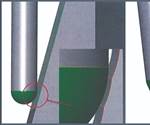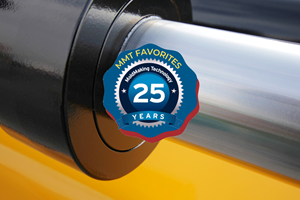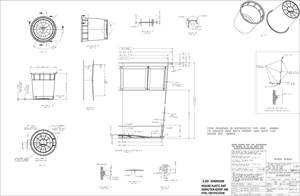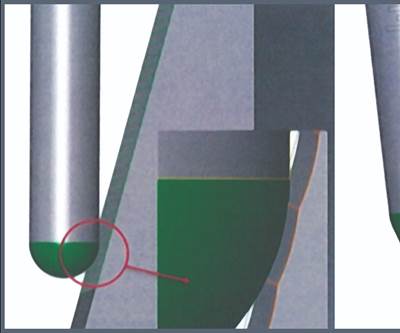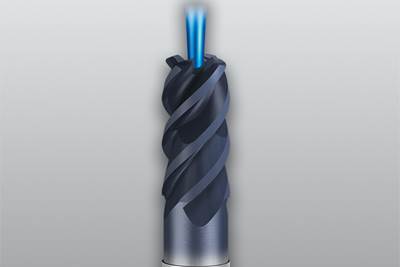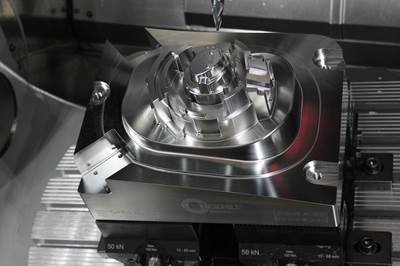
Circle segment end mills save time and produce superb surface finishes when finishing free-form surfaces and hard-to-reach areas like this automotive mold depicted above. Source | iStock
Traditionally, ballnose end mills were the go-to for smooth surface finishes. However, their limitations, especially for extensive surface finishing, have become increasingly apparent. The small stepover of a ballnose end mill, typically between 3-5% of the tool diameter, results in limited material contact. This necessitates more passes to achieve an optimal surface finish, leading to excessive stress and wear on the cutting tool. The reduced stepover length also increases manufacturing cycle time due to the need for additional cutting tool passes.
By mapping only a part of the circle (a circle segment) on the end mill, a new end mill design, the circle segment or conical barrel, is born. This design, with its unique forms and large radii in the cutting area, enables more expansive stepovers that cut wide swaths of material. The result? Fewer tool paths, maximized tool life, increased efficiency and most importantly, minimized manufacturing cycle time.
The large radial stepover, a key feature of the circle segment or conical barrel end mill design, results in higher cutting forces than standard ballnose cutters. This is due to the large radii on the cutting edges. When compared to a conventional ball mill, the large radius simulates a ballnose end mill that would have a cutting diameter of 12 to 3,000 millimeters and even larger.
The circle segment or conical barrel end mill design minimizes tolerance deviations caused by heat warping the cutting tool and smooths out axial deviations of the machine. These end mills also provide much greater material removal with fewer passes in five-axis machining, resulting in cycle time reductions of more than 80% and up to 50% finer surface finishes.

CAM software enables circle segment cutting tools to access vertical and steep areas with tangent plane machining and to be effective on any flat or shallow area. Source | Open Mind Technologies
Circle Segment Technology in Action
Here is a real-world moldmaking application that demonstrates the practical benefits of using circle segment end mills. An automotive plastic injection molder has reaped big productivity gains using taper form circle segment end mills when finishing complex molds with five-axis machining. The taper form is a versatile cutting tool that provides access to hard-to-reach areas such as bottom surfaces, wall surfaces, free-form surfaces and fillets.
Most of the molds the company manufactures are quite large, sometimes up to 10 feet long and approximately 5 feet wide, such as a car bumper. However, sizes vary and may include a cupholder, shift lever, dashboard, engine bay and many other parts.
Generally, the mold material is P-20 tool steel with a hardness of 32/34 HRC. The molds have multiple surfaces requiring milling with a high degree of tapers, radiuses, contours and angles on both the inner and outer mold halves. The molds also include deep lifter pockets with restricted access that perform a demolding action by lifting the plastic part out of the mold. A robot then grips and transfers the part to the next operation.
Due to the mold contours, a flat square end mill was not an option, so a ball-nose cutter with a radius was previously used. However, a ball-nose type limits the amount of material that can be cut per pass because the contact of the ball is very small, requiring many passes and resulting in longer machining times.
With the circle segment cutter, the effective cutting radius is much larger. For example, both the ballnose and circle segment are 12 millimeters, but the ballnose has a 6-millimeter radius and the circle segment end mill has a 250-millimeter cutting radius.
Circle segment end mills work in conjunction with other end mill types to cut particular features of a mold. However, where circle segment end mills can reach, they can reduce cutting time by over 80% from conventional techniques and cutting tools.
One of the programmers immediately recognized the benefits of the circle segment cutting tool. To ensure optimal machining rigidity, a shrink-fit toolholder was utilized. This combination provided ample reach for the necessary accessibility, especially for larger molds.
The mold builder is very satisfied with the surface finishes and is now able to complete the finishing processes in approximately 80% less time on average compared to when using the previous ball-nose cutters. Also, tool life has doubled since switching to circle segment technology, resulting in an overall machining cost reduction of up to 70%, which is over $50,000 annually.

Finishing tire molds, which include, vertical, steep angles in hard-to-reach pockets, can benefit from circle segment end mill technology. Source | iStock
Circle segment end mills work in conjunction with other end mill types to cut particular features of a mold. However, where circle segment end mills can reach, they can reduce cutting time by over 80% from conventional techniques and cutting tools.
Another example is a large fascia mold, where surfaces can be machined using tangent plane machining. This method is particularly beneficial for deep pockets that are difficult to machine using a standard end mill for side milling. Traditionally, these areas would be machined using a ball-nose end mill with a tight stepover. However, larger ball end mills leave more material in the corners, requiring additional passes to remove it.
Circle segment end mills provide a great solution. They can easily reach vertical corners and the floors of deeper pockets. What's interesting about cutting with circle segment cutters is that it's quite similar to traditional milling with carbide ball end mills. The unique cutter features are ground onto a standard end mill shank (for example, 16 or 12 millimeters).
The cutting parameters are determined by the effective diameter, number of cutting edges and the workpiece material. Start with the recommended cutting speed and feed, then adjust to fit the cutting conditions.
The large cutting radius and increased contact area on the part may cause a slight reduction in feed rate due to the increased cutting forces. However, despite this reduction, the overall cutting effectiveness is much higher than that of a ball end mill due to the increased stepover between paths. The stepover distance is calculated in the same way as with a ball end mill and is often set to produce a desired, scallop height. For the right application, a circle segment cutter is very easy to implement in production.
Every mold requires a specific surface finish. The aim is to meet or exceed this requirement, and circle segment cutting technology can help achieve these values in a shorter time. By improving surface quality efficiently, it is possible to minimize the need for post-polishing work.
For this mold, the ballnose end mill took approximately nine hours and 36 minutes to complete, whereas the circle segment end mills took an estimated machining time of only one hour and 10 minutes. This accounted for an 88% reduction in machining cycle time.
It's important to note circle segment technology requires CAM software capable of producing the correct tool paths. With the appropriate CAM software, these tools can be used for tangent plane machining in vertical and steep areas, as well as machining flat or shallow areas. This versatility improves efficiency and surface finish quality.
Use CAM software that fully and automatically controls the milling cutter contact point during machining, as the angle of the cutter is continuously changing. This control ensures safe machining of the entire surface and uniform utilization of the cutting radius.
Use CAM software that can parametrially define all circle segment cutters, eliminating the need for users to create free blade geometries or design the milling tool based on 2D contours. With simple tool management and a CAM system that accurately maps the barrel cutters, you can ensure 100% safe and reliable use of these tools.

With circle segment end mills, machining times can be reduced significantly and at the same time the surface quality of the components is increased. Source | Emuge-Franken USA
When using circle segment cutters, the software needs to be developed by the CAM provider in order to support the circle segment tool shape and generate tool paths. If the user doesn’t have the current version, or if their CAM product doesn’t support circle segment, then they are limited in their options, and may need to consider switching to a different CAM product that is better equipped to handle circle segment tool paths.
When looking for software, seek out companies that provide compatible programs for circle segment machining. The benefits of using such software and circle segment cutters are significant and the return on investment is often realized within a year.
The examples presented in this article are intended to help you visualize the impact of this technology in your work.
Related Content
Machining Center Spindles: What You Need to Know
Why and how to research spindle technology before purchasing a machining center.
Read MoreMaintaining a Wire EDM Machine
To achieve the ultimate capability and level of productivity from your wire EDM on a consistent, repeatable and reliable basis, regular maintenance is a required task.
Read MoreHow to Correctly Size a Hydraulic Cylinder
This week Randy shares steps for correctly sizing a hydraulic cylinder on a mold.
Read MoreIt Starts With the Part: A Plastic Part Checklist Ensures Good Mold Design
All successful mold build projects start with examining the part to be molded to ensure it is moldable and will meet the customers' production objectives.
Read MoreRead Next
Improving Finishing Operations with Circle Segment Cutters
Circle segment cutters are a concept in cutting tool design that allows for maximum production rates while still achieving excellent surface finish.
Read MoreHow a Small Programming Change Cuts Cycle Time in Half
Overriding the CAM system when milling a series of lifter pockets helps to improve metal removal rate and increase feed rates.
Read MoreTen Things You Need to Know about Circle Segment Milling
Considerations for evaluating if circle segment end mills or conical barrel cutters are right for your mold machining applications.
Read More

